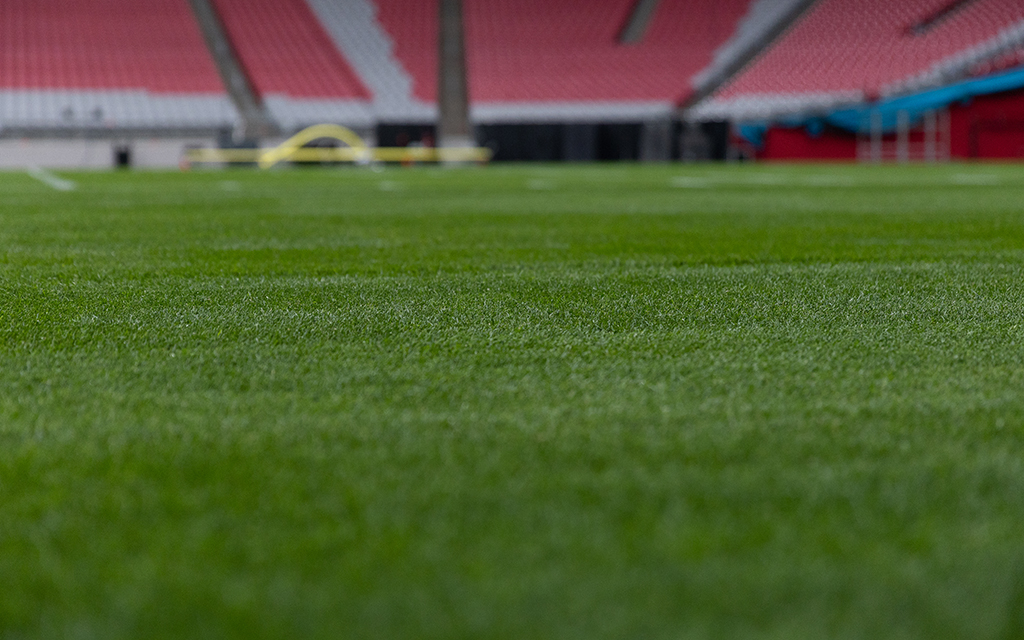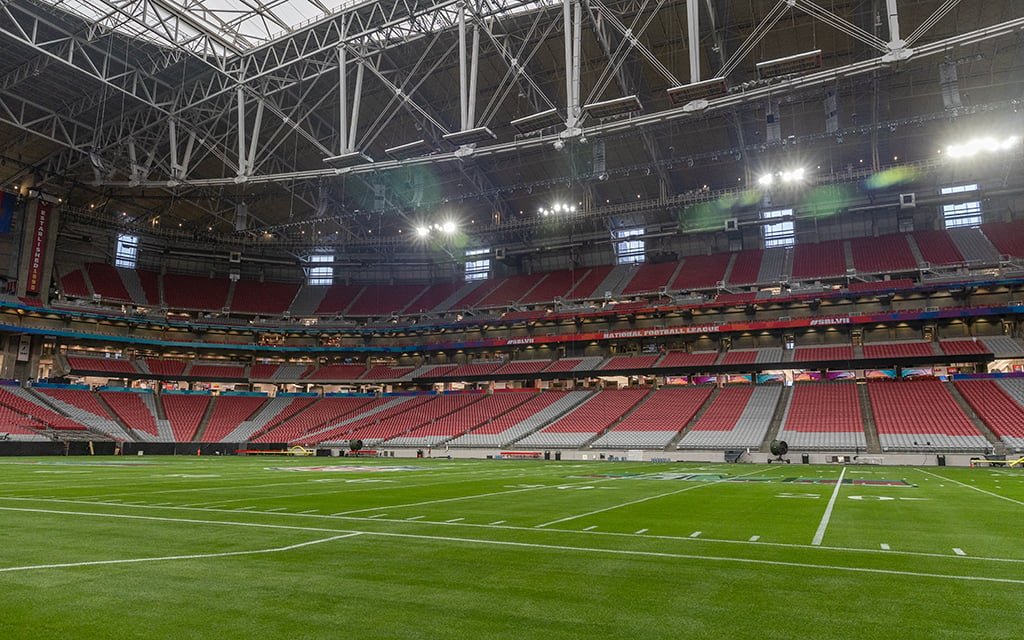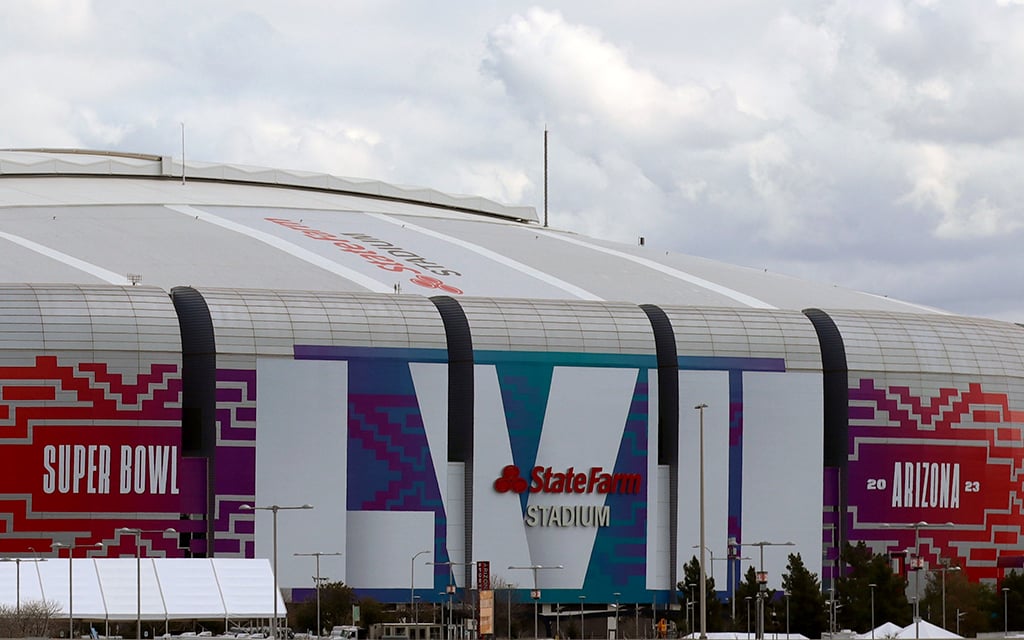GLENDALE – From fresh green grass to brand new turf, playing surfaces have been at the forefront of NFL headlines this season, and with all eyes on the biggest game of the year, State Farm Stadium workers have the task of making the field pleasing to viewers while also keeping the players safe.
The NFL’s issue with playing surfaces was highlighted last year during the 2022 Super Bowl when L.A. Rams star receiver Odell Beckham Jr., went to catch a pass late in the second quarter on SoFi Stadium’s artificial turf and collapsed in a heap of pain as soon as he turned upfield. It was later revealed that the non-contact injury was a torn ACL.
Fellow NFL players flooded Twitter after the incident, voicing their opinions on turf fields along with the message, “I support #FLIPTHETURF”.
I don’t like artificial turf, I love grass! It’s better for my body, our team performance, AND the planet. Help us #FlipTheTurf by signing the petition https://t.co/Douk19hpSv with @PenningtonLawn #penningtonpartner pic.twitter.com/i2WE7mgajS
— George Kittle (@gkittle46) February 11, 2022
Every player is one play away from altering their career forever when playing on turf. I experienced the
bad side of this and it could have been avoided. Help me #FlipTheTurf to real grass with @penningtonlawn. Sign here: https://t.co/zAUcWTBDJy #penningtonpartner pic.twitter.com/NXpqC8bGMo— Nick Bosa (@nbsmallerbear) February 14, 2022
Players noticing this difference have validity based on the NFL injury data collected from 2012 to 2018. This data showed that contact injury rates for lower extremities were higher during practices and games played on artificial turf.
The major difference comes in non-contact lower-extremity injuries with a 28% higher rate of these injuries occurring on artificial turf. Of those non-contact injuries, there is a 32% increase in the rate of non-contact knee injuries and a 69% increase for non-contact foot/ankle injuries on turf compared to grass.
All this resurfaced during the 2022 NFL season due to multiple non-contact injuries at MetLife Stadium, home of the New York Giants and New York Jets. The stadium’s artificial turf is slit turf, a surface the NFL admitted contributed to an increase in lower-extremity injuries.
The recent outcry is something to watch during the 2023 Super Bowl as the big game moves back to natural grass.
On Super Bowl Sunday, the Philadelphia Eagles and Kansas City Chiefs will break in the brand new field made from grass that was grown locally just outside Phoenix.
“The field started its growth pattern over a year ago for the Super Bowl,” said Ed Mangan, NFL field director. “The field is maintained seven days a week up until this point. We brought out our laser graders and laser level to make everything perfectly smooth.”
The field is rolled into State Farm Stadium in sections that are 3 1/2 feet wide and 40 feet long, weighing in at approximately 1,500 pounds.
“We roll every piece out like a carpet,” said Mangan. “Then make sure everything is smooth and put all the edges together.”
In total it took four days to lay the grass down and a week and a half to sod the field.
Now the field is in the hands of the grounds crew, a mix of local staff and members brought in from around the country. In total there are around 35 people who work seven days a week to have the game and practice fields in the best condition possible.
One of those members brought in is Nick Pappas, who also worked on the fields in the NFL’s Germany and England games. One advantage of having the field in State Farm Stadium is the rollers that can move the grass outside.
“Being able to move the field in and out gives us the opportunity to do more inside the stadium,” Pappas said. “When the field is outside it gets sunlight and the weather that is needed to be in the best condition possible. At night we can bring the field in as temperature drops or if we want to avoid certain weather patterns, we can bring the field in. It is a huge opportunity for us to provide the best service we can.”
Eleven days before the 2023 Super Bowl and the paint for the essential grid of the field is ready to go.
“We are at 85% at this point with painting the field,” Pappas said. “As the grass grows, the paint dulls out so a lot of the work this week is measuring everything to make sure we get the layout right the first time. We lay down the final coat as game day approaches to make sure the lines, numbers and hashes are clear for the officials with the logos bright for everyone to see.”

The playing field for Super Bowl 57 will undergo final testing over the next 11 days to ensure it meets quality standards. (Photo by Susan Wong/Cronkite News)
Another major attraction for the Super Bowl is the halftime show featuring Rihanna as the performer this year.
“We work hand in hand with that team (halftime show team) to ensure that everything works together, and we minimize the impact on the grass itself,” said Eric Finkelstein, NFL senior director of events planning.
Having a new field for the Super Bowl also comes with player health and safety concerns no matter the type of grass.
“We constantly test the field over the next couple of weeks to ensure that it performs at the level we anticipate and expect,” Finkelstein said. “We do everything we can to minimize the amount of foot traffic and movement on the field because we are sensitive towards making sure that the field is as pristine and performs at the highest possible level.”
While the field must be attractive to fans at State Farm Stadium and for the millions watching the big game on TV, the health of Eagles and Chiefs players come kick-off is the main priority.
“There is nothing like that moment when the ball is kicked off,” said Finkelstein. “All the work that has gone into that point finally comes together. It is the biggest moment in the lives of these two teams and their fans. We want to make sure everything is perfect and ready for that moment, but when you (have) the flash bulbs going off there is no moment like it in sports.”



